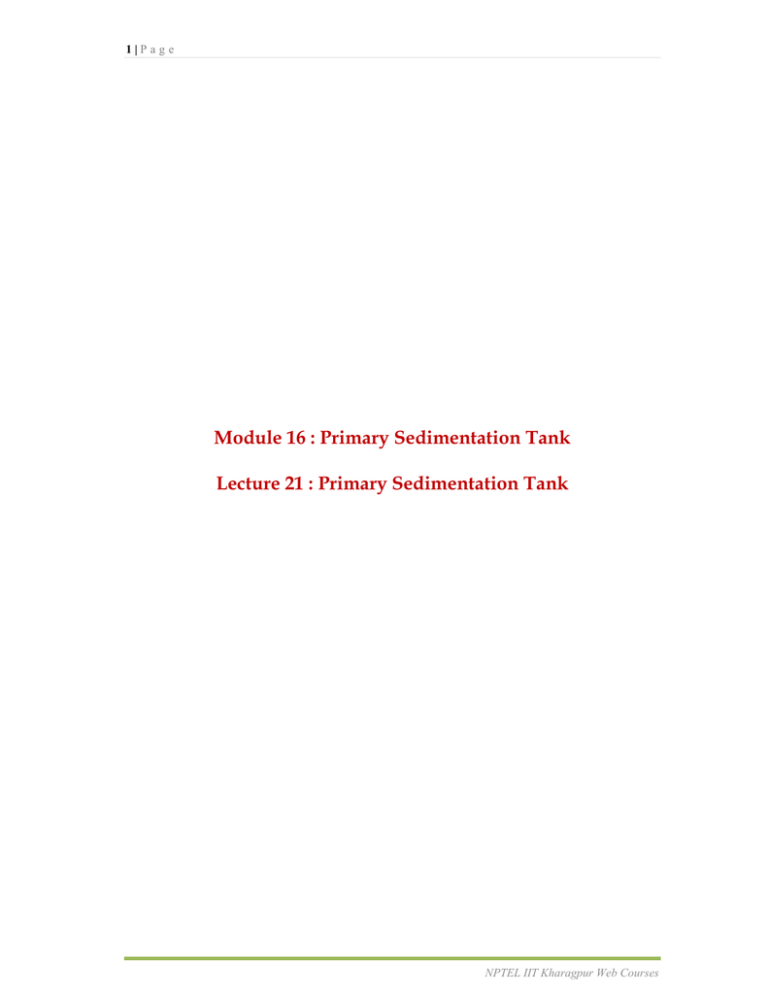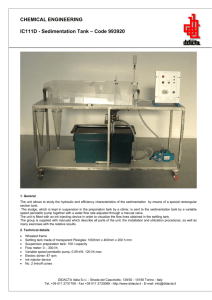Primary Sedimentation Tank
advertisement

1|Page Module 16 : Primary Sedimentation Tank Lecture 21 : Primary Sedimentation Tank NPTEL IIT Kharagpur Web Courses 2|Page After grit removal in grit chamber, the wastewater containing mainly lightweight organic matter is settled in the primary sedimentation tank (PST). Due to involvement of many unknown parameters under settling of light weight, sticky, and non regular shaped particles, the classical laws of sedimentation as applicable in grit removal are not valid and this settling is called as flocculant settling. The primary sedimentation tank generally removes 30 to 40% of the total BOD and 50 to 70% of suspended solids from the raw sewage. The flow through velocity of 1 cm/sec at average flow is used for design with detention period in the range of 90 to 150 minutes. This horizontal velocity will be generally effective for removal of organic suspended solids of size above 0.1 mm. Effluent weirs are provided at the effluent end of the rectangular tanks, and around the periphery in the circular tanks. Weir loading less than 185 m3/m.d is used for designing effluent weir length (125 to 500 m3/m.d). Where primary treatment follows secondary treatment, higher weir loading rates can be used. The sludge collection hopper is provided near the centre in circular tank and near the influent end in rectangular tanks. A baffle is provided ahead of the effluent weir for removal of floating matter. This scum formed on the surface is periodically removed from the tank mechanically or manually. 16.1 Analysis of Flocculant Settling Particles in relatively dilute concentration with smaller size sometimes will not act as discrete particles (as the grit particles behave in grit chamber) but these particles will coalesce during sedimentation. As flocculation occurs, the size of the particle increases and it settles faster. The magnitude of flocculation will depend upon the opportunity for contact between the particles, which depends upon overflow rate, temporal mean velocity gradient in the system (representing mixing) and concentration and size of the particles. Although, settling rate of particle is independent of depth of basin, the basin depth will decide liquid detention time in the tank and sufficient depth should be provided for settling to separate it from sludge settled zone. The effect of these variables on settling can only be determined by sedimentation tests, and classical laws of sedimentation are not applicable, due to change in characteristics of the particle during settling. Settling column is used to determine the settling characteristics of the suspension of flocculant particles. A column with diameter of 15 cm and height of 3.0 m can give satisfactory results, with 5 to 6 ports provided over the height for sampling. The height of the tank should be ideally equal to side water depth of the settling tank for proper results. NPTEL IIT Kharagpur Web Courses 3|Page The solution containing suspended solids should be added in the column in such a way that uniform distribution of solid particles occur from top to bottom. Settling should takes place under quiescent conditions. It is important to maintain uniform temperature throughout the experimental column to avoid convection currents. At various time intervals, samples are withdrawn from the ports and analyzed for suspended solids. Percentage removal of solids is calculated for each sample analyzed and is plotted as a number (%) against time and depth. The curve of equal percentage removal is drawn between the plotted points. The efficiency of the sedimentation tank, with respect to suspended solids and BOD removal, is affected by the following: Eddy currents formed by the inertia of incoming fluid, Wind induced turbulence created at the water surface of the uncovered tanks, Thermal convection currents, Cold or warm water causing the formation of density currents that moves along the bottom of the basin, and Thermal stratification in hot climates. Because of the above reasons the removal efficiency of the tank and detention time has correlation R = t/(a+b.t), where ‘a’ and ‘b’ are empirical constants, ‘R’ is expected removal efficiency, and ‘t’ is nominal detention time. To account for the non optimum conditions encountered in the field, due to continuously wastewater coming in and going out of the sedimentation tank, due to ripples formed on the surface of the water because of wind action, etc., the settling velocity (overflow rate) obtained from the column studies are often multiplied by a factor of 0.65 to 0.85, and the detention time is multiplied by a factor of 1.25 to 1.50. This will give adequate treatment efficiency in the field conditions as obtained under laboratory test. Example: 1 The settling test was performed in the settling column of height 2.5 m. Four numbers of ports were provided to the column at the height of 0.5 m from bottom. Samples were collected from these ports at every 30 min and the results obtained are plotted in the Figure 16.1. Determine the overall removal of solids after 1.0 h of settling. NPTEL IIT Kharagpur Web Courses 4|Page ∆ h1 Height of column ∆ h2 ∆ h3 40% 50% 60% 80% ∆ h4 30 60 70% 90 120 0.5 m 150 Time of sampling, min Figure 16.1. Results of the settling column study Solution Percentage removal = ∆ h1x (R1 + R2) + ∆ h2 x (R2 + R3) + ∆ h3x (R3 + R4) + ∆ h4 x (R4 + R5) h5 2 h5 2 h5 2 h5 2 For curve shown in the Figure 16.1, the computation will be ∆ h1x (R1 + R2) = 0.34(100+80)/(2.5 x 2) = 12.24% h5 2 ∆ h2 x (R2 + R3) = 0.16 (80 + 70)/(2.5 x 2) = 4.8% h5 2 ∆ h3x (R3 + R4) = 0.66 (70 + 60)/(2.5 x 2) = 17.16% h5 2 ∆ h4 x (R4 + R5) = 1.34 (60 + 50)/(2.5 x 2) = 29.48% h5 2 Therefore, total removal under quiescent settling condition is 63.68%. To achieve this removal the detention time recommended in settling tank is 1 x 1.5 = 1.5 h. 16.2 Recommendation for Design of Primary Sedimentation Tank Primary sedimentation tanks can be circular or rectangular tanks (Figure 16.2) designed using average dry weather flow and checked for peak flow condition. The numbers of tanks are determined by limitation of tank size. Two tanks in parallel are normally used to facilitate maintenance of any tank. The diameter of circular tank may range from 3 to 60 m (up to 45 m typical) and it is governed by structural requirements of the trusses which supports scrapper NPTEL IIT Kharagpur Web Courses 5|Page in case of mechanically cleaned tank. Rectangular tank with length 90 m are in use, but usually length more than 40 m is not preferred. Width of the tank is governed by the size of the scrappers available for mechanically cleaned tank. The depth of mechanically cleaned tank should be as shallow as possible, with minimum 2.15 m. The average depth of the tank used in practice is about 3.5 m. In addition, 0.25 m for sludge zone and 0.3 to 0.5 m free board is provided. The floor of the tank is provided with slope 6 to 16 % (8 to 12 % typical) for circular tank and 2 to 8% for rectangular tanks. The scrappers are attached to rotating arms in case of circular tanks and to endless chain in case of rectangular tanks. These scrappers collect the solids in a central sump and the solids are withdrawn regularly in circular tanks. In rectangular tanks, the solids are collected in the sludge hoppers at the influent end, and are withdrawn at fixed time intervals. The scrapper velocity of 0.6 to 1.2 m/min (0.9 m/min typical) is used in rectangular tank and flight speed of 0.02 to 0.05 rpm (0.03 typical) is used in circular tank. Inlets for both rectangular and circular tanks are to be designed to distribute the flow equally across the cross section. Scum removal arrangement is provided ahead of the effluent weir in all the PST. The surface overflow rate of 40 m3/m2.d (in the range 35 to 50 m3/m2.d) is used for design at average flow. At peak flow the surface overflow rate of 80 to 120 m3/m2.d could be used when this PST is followed by secondary treatment. Lower surface settling rates are used when waste activated sludge is also settled in the PST along with primary solids. In this case the surface overflow rate of 24 to 32 m3/m2.d and 48 to 60 m3/m2.d are used for average and peak flow conditions, respectively. The weir loading rate less than 185 m3/m.d is used for designing effluent weir length (in the range 125 to 500 m3/m.d). Weir loading rate up to 300 m3/m.d is acceptable under peak flow condition. Higher weir loading can be acceptable when primary treatment is followed by secondary treatment. As such the weir loading rate has very less impact on the overall performance of sewage treatment plant when secondary treatment is provided after primary treatment. The detention time in PST could be as low as 1 h to maximum of 2.5 h. Providing detention time of 1.5 to 2.5 h at average flow is a common practice. To avoid resuspension (scouring) of settled particles, horizontal velocities through the PST should be kept sufficiently low. Following equation by Camp can be used to calculate the critical velocity, Vc, which is the horizontal velocity that will just produce scour (m/sec). NPTEL IIT Kharagpur Web Courses 6|Page 8 Vc g ( S 1) D f (1) Where, = constant = 0.04 for unigranular sand = 0.06 for non-uniform sticky material f = Darcy –Weisbach friction factor = 0.02 to 0.03 g = Gravity acceleration, S = Specific gravity of the particle to be removed (1.2 to 1.6) D = Diameter of the particle, m For organic particle with size of 0.1 mm and specific gravity of 1.25 this velocity will be about 0.063 m/sec. Figure 16.2 (a) Rectangular and (b) Circular primary sedimentation tank Example: 2 Design the primary sedimentation tank to treat wastewater with average flow rate of 10 MLD and peak flow of 22.5 MLD. Solution Assume surface settling rate = 40 m3/m2.d Therefore, the surface area of the tank = 10 x 106 / 40 x 103 = 250 m2 Check for peak flow condition: The SOR at peak flow = 22.5 x 103 /250 = 90 m3/m2.d 7|Page This is less than the recommended value at peak flow. Assume width = 6.0 m Therefore theoretical length = 250/6 = 41.66 > 40 m Hence, provide two tanks in parallel Total length of each tank = 41.66/2 + 2 (inlet) + 2 (outlet) = 24.83 say 24.85 m Now, Flow rate x detention time = depth x surface area = volume of tank or Flow / Surface area = depth / detention time = Surface settling rate Provide detention time of 1.5 h Therefore, liquid depth required Therefore, flow through velocity = 40 x 1.5 / 24 = 2.5 m 3 = (0.116 m /sec) / (2 x 2.5 x 6) = 0.0039 m/sec < 1 cm/sec hence O.K. At peak flow, the flow through velocity = 22.5 x 103 /(2 x 6 x 2.5) = 750 m/d = 0.0087 m/sec. (Horizontal velocity should be checked for non-scouring velocity i.e. less than 0.06 m/sec.) Provide total depth = 2.5 + 0.5 (free board) + 0.25 (space for sludge) = 3.25 m Weir loading rate = 10 x 103 / 12 = 833.33 m3/m.day > 185 m3/m.day Length of weir required = 10 x 103 / 185 = 54.05 m Hence, provide about 27.1 m of weir length for each tank. This can be provided by two effluent collection channels across the width at outlet end offering total 24.0 m and side weir of total 1.55 m on each side. NPTEL IIT Kharagpur Web Courses 8|Page Questions 1. Describe flocculant settling. 2. What is the purpose of providing primary sedimentation tank in wastewater treatment? What is the expected BOD and SS removal is primary sedimentation tank? 3. What are the parameters which will govern performance of PSTs? 4. Describe design guidelines for primary sedimentation facilities. 5. Design circular and rectangular PST for treatment of 4 MLD of average sewage flow with peaking factor of 2. Answer: 3 2 Q. 5. Assume surface settling rate = 40 m /m .d; For rectangular tank: Width = 5 m, Length = 24.0 m, Liquid depth = 2.5 m two tanks. For circular tank: Provide 11.5 m diameter two tanks with side water depth of 2.5 m. NPTEL IIT Kharagpur Web Courses




